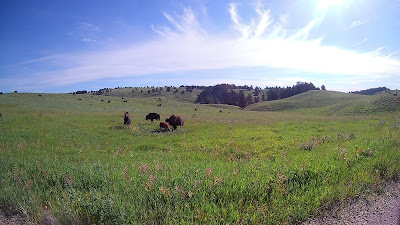Bison, Mountain Goats, and Bighorn Sheep
Guest post by Clemson Montana Summer Program student Brandi Wold
I noticed that the further west you traveled, the more
mountainous the state became. Additionally, the further east you traveled, the
more flat it became. Along our journey throughout the southeastern region of
the state, you can see the transition of animals and their habitats. It was
noted in the journal of Meriwether Lewis on his travels, that as he looked around
the landscape on top of a hill, he could see bison, wolves, bears, elk, and
rams scattered throughout the horizon. Today you’ll be lucky to see any of
these species outside a park, protected area, or reservation. However, at a
stop we made in Badlands National Park, there was a moment of what the Great
Plains was supposed to be. In a small “mini prairie” there was a lone bull
bison, pronghorn and their young, burrowing owls, prairie dogs, and deer in the
distance all coinhabitating in such a small area. I thought of it as a rare sight to see, and felt truly blessed because as I tried to capture it with my camera
to share with friends and family, I realized that I could not capture the pure
awe and emotion that overwhelmed me.
Montana is home to a diverse assortment of animals that
include 14 amphibians, 90 fish, 117 mammals, 30 reptiles, and 427 bird species.
Additionally, there are over 10,000 invertebrates including 180 mollusks, and 30
crustaceans. Montana is also home to five federally endangered species, which
are the black-footed ferret, whooping crane, least tern, pallid sturgeon, and
white sturgeon and seven threatened species including the grizzly bear,
Canadian lynx, and bull trout. The Montana Department of Fish, Wildlife and
Parks manages fishing and hunting season for at least 17 species of game fish
including trout, walleye, and small-mouth bass and at least 29 species of game
birds and animals including the ring-necked pheasant, grey partridge, elk,
pronghorn antelope, mule deer, whitetail deer, grey wolf, and bighorn sheep.
Traveling in South Dakota between Wild Idea Bison Co., Custer
National Park, and Badlands National Park, I observed the behavior of the
bison. I saw bighorns on the dry, steep crumbly soil of the badlands to evade predators, and mountain goats jump and climb the more sturdy granite and
mica-schist rocks in the mountains of Custer National Park. In the Conata Basin, while inspecting a
wallow left behind by a bison, I learned that these micro-habitats house
cricket frogs and spadefoot toads. I was at first alarmed, but then I
remembered that I used to catch toads all the time in Illinois. However, the
frogs came to me as more of a surprise because these wallows are not permanent
water sources which are a necessity for all frogs. Even tiger salamanders, which I thought was
unusual for salamanders to be in such a high altitude and rapidly changing
environment, have adapted as they burrow down into the soils to escape the
harsh elements of winter and the dry, windy days of summer.




